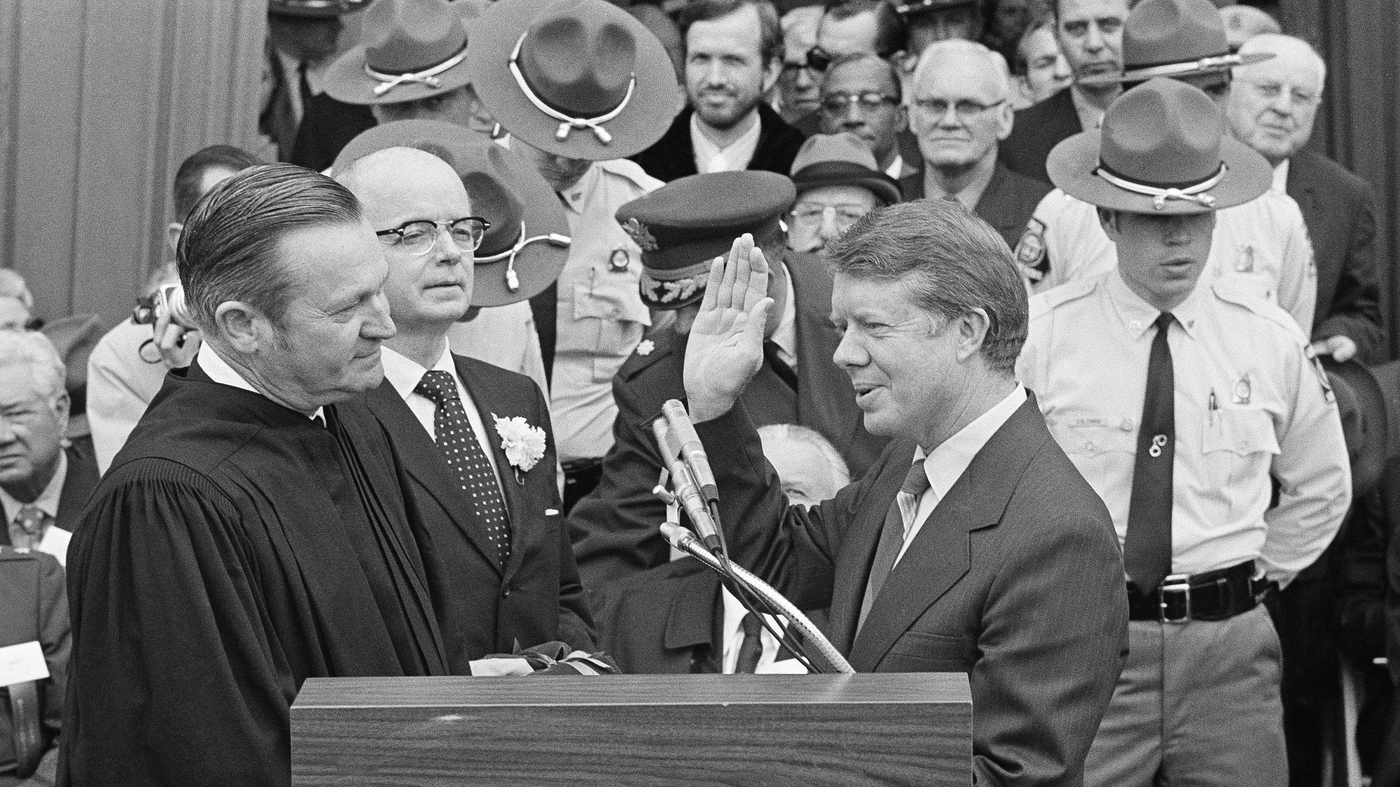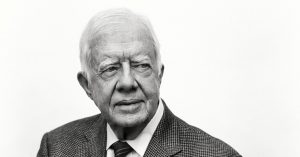
The single White House term of Carter remains controversial after more than 40 years
Jimmy Carter: The White House Years: The Rise and Fall of the U.S. Prelude to the War on Iraq and the Middle East
He opposed the Gulf War in 1991 and the U.S. invasion of Iraq in 2003, and he angered many when he likened Israel’s treatment of Palestinians to apartheid in South Africa. He also riled many Americans by suggesting that opposition to President Barack Obama was rooted in racism. He gained the admiration and dislike of many with his public disapproval of President Donald Trump.
As former president, Carter did not shy from controversy, particularly when it came to the Middle East, the region that gave him his greatest foreign policy achievement and also his most damaging setback as president.
History will judge Jimmy Carter as a president in the future. He’s, I would argue, the most intelligent and hardworking and decent man to have occupied the Oval Office in the 20th century.
But the greatest factor in Carter’s rising reputation was his own performance in his post-presidential career. He worked with Habitat for Humanity to rehabilitate homes for low-income families. He established his own organization, the Carter Center. And over the ensuing decades, he published more than two dozen books and became an international advocate for peace, democratic reforms and humanitarian causes.
In 2018, Stuart E. Eizenstat, Carter’s chief domestic policy adviser, published President Carter: The White House Years, which historians have praised both as a primary source and as an assessment of Carter’s term. In it, Eizenstat wrote that Carter “was not a great president, but he was a good and productive one. He delivered many results after he left office. He was a man who believed in his principles. Yet his greatest virtue was at once his most serious fault for a president in an American democracy of divided powers.”
Carter left office with a Gallup poll approval rating that was in the low 30’s, but historians generally have not rated his presidency highly. But there has been a steady upward trajectory in assessments of his presidency in recent years, and his Gallup approval rating has climbed back above 50% and has remained there among the public at large.
While Carter’s juggernaut lost momentum in the summer and fall, with Republican President Gerald Ford nearly closing the polling gap by Election Day, the Georgian held on to win 50% of the popular vote in November. In the end, Carter was able to cobble together nearly 300 Electoral College votes even though he did not win his home state or any of the other states.
The election looked close at Labor Day and even into October. The one debate the two camps agreed to was a clear victory for the challenger. Carter didn’t succeed in his attempt to paint Reagan as crazy. The Republican managed to be reassuring and upbeat even as he kept up his attacks on Carter’s handling of the economy and on the rest of Carter’s record.
After a come-from-behind win in New Hampshire and a sweep of the Southern primaries, Reagan never looked back. His triumph at the Republican National Convention in Detroit set the tone for his campaign.
Ronald Reagan was a former two-term governor of California who had sought the nomination twice before, and he did not begin 1980 as the consensus choice of his party. A set of issues were woven into a fabric with broad appeal. He proposed tax cuts that would make the economy stronger and more efficient, and more spending on defense, as well as a return to the traditional values of faith, family, work and neighborhood. He also opposed abortion and busing for racial integration and favored school prayer — the three hottest buttons in social policy at the time.
Carter was able to deflate the challenge to his nomination by using the hostage crisis. Carter had a debate with Kennedy that was kind of a referendum on the Iranian situation. Kennedy’s bid, a favorite cause of labor and liberal activists, fell far short and enough Democrats rallied to his side. Still, it contributed to the weakness of Carter’s standing in the general election. When Carter faced the Republican right, what had worked against the challenger from the Democratic left did not work.
Yet another blow was dealt to Carter’s standing when the Soviet Union invaded Afghanistan to prop up its client regime there. Carter’s decision to have the US boycott the 1980 Olympics in Moscow was less popular than opposing that aggression.
Yet the Iranian crisis had even worse consequences. The revolution saw the overthrow of the Shah, a well known ally of the U.S., and the installation of a stern theocracy led by the critic of the U.S. When Carter agreed to grant the Shah a visa to receive cancer treatments in the U.S., young followers of the ayatollah overran the U.S. Embassy in Tehran. Fifty-two Americans were taken hostage for 444 days. Carter’s efforts to free them were unavailing. Eight US service members died in a plane crash after a raid to free them in the Iranian desert.
Carter and the Democrats paid a price, suffering more than the usual losses for the president’s party in the 1978 midterm elections, which greatly reduced Democratic margins in both the House and the Senate.
In 1976, James Earl Carter Jr. was elected as the 39th president of the United States, replacing Gerald Ford. Carter’s term in the White House would be plagued by inflation, energy shortages, and foreign crises. He won the nomination for a second term.
Carter had only 2% national name recognition when he announced, but he believed he could make a strong showing in the early presidential caucuses and primaries by meeting as many people personally as possible. He embarked on a 37-state tour, making more than 200 speeches before any of the other major candidates had announced.
His four decades as a very active former president ended on Sunday in his hometown of Plains, Ga. He lived longer than all the other U.S. president and had battled cancer in his 90s.
He lost his bid for reelection to Republican Ronald Reagan in a landslide in 1980. Thereafter, he worked with Habitat for Humanity and traveled the globe as an indefatigable advocate for peace and human rights. In 1998 he received the U.N. Prize in the Field of Human Rights and in 2002 he won the Nobel Peace Prize.
In that contest, he finished behind another Democrat, Lester Maddox, a populist figure known for brandishing a pickax handle to confront civil rights protesters outside his Atlanta restaurant.
Carter was familiar with the traditional white Southern cultural identity. But he was also noted for his support for integration and the Civil Rights Movement led by fellow Georgian Martin Luther King Jr. Four years after losing to Maddox, Carter was elected his successor and declared in his inaugural speech that “the time for racial discrimination is over.”
Time magazine would feature him on its cover four months later, making him a symbol of the “New South.” When his term as governor ended he threw his hat in the ring for the presidency. But he did not burst onto the national stage so much as he crept up onto it, appearing before small groups in farming communities and elsewhere far from the big media centers.
Carter had a clever game plan based on the new presidential nominating rules that the Democrats adopted in the early 1970s. Carter’s team, led by campaign manager Hamilton Jordan, mastered this new road map and Carter went from a strong showing in Iowa to a clean win in New Hampshire. So though in January 1976 he was the first choice of only 4% of Democrats nationally, he won the first two events and leveraged that attention to capture the imagination of voters in other regions.
Wherever he went, he was able to connect with rural voters and evangelicals wherever they were to be found — doing well in big cities but also in the sparsely populated parts of Ohio and Pennsylvania.
The small margin of Carter’s win over Ford boded ill for the future. The Carter persona didn’t fit in Washington he found in 1977 because of the nature of the national mood at the time. Presidential candidates who run against Washington have to adjust their tactics if and when they are elected. The former peanut farmer and his staff believed that they had leverage they didn’t know about.
Almost immediately upon taking office, Carter encountered difficulties with various power centers in Congress. He and his tight circle of aides brought along from Georgia and the campaign were not attuned to congressional customs or prerogatives, and a variety of their agenda priorities ran afoul of their own party’s preferences.
Carterites viewed pork barrel spending as unnecessary when it came to the “hit list” of Western water projects. For a raft of Democratic senators and representatives facing reelection in thirsty states and districts, the list came as a declaration of war. Although Congress fought Carter to a draw on the projects, many of these Western seats would be lost to Republican challengers in 1978 and 1980.
Carter secured the Senate’s approval of his treaties ceding the Panama Canal to Panama and brokered a historic peace deal between Israel and Egypt. Significant reforms in regulations, including ones affecting energy production and transportation, helped him achieve a lower consumer prices.
Carter had taken office amid historically high inflation and energy prices that had persisted since the Arab oil embargo of 1973. Carter appointed a new chair of the Federal Reserve, Paul Volcker, whose tight money policies eventually tamed inflation but also triggered a recession and the highest unemployment rates since the Great Depression. Along the way, there was more grief on the oil front as Iran’s Islamic Revolution in 1979 caused not only a price spike but long lines at the pump — worse than in 1973.
Jay Carter, former president, educator and activist: “When racial discrimination fails” Kai Bird, biographer and author of The Outlier: The unfinished presidency of Jimmy Carter
Bird: Yes. He said in that famous speech that too many of us now worship self-indulgence and consumption. He just read Christopher Laschic’s The Culture of Narcissism and decided to follow suit. But this also spoke to his Southern Baptist sense of morality and righteousness. It was a sermon. And I think it’s very prescient today, because we’re still living in a culture, a political culture that is quite narcissistic.
Inskeep: In 1979, he gave a famous speech about a crisis of confidence in America, doubt about the meaning of our own lives. I’m quoting his words saying, ‘A loss of unity, of purpose for our nation, the erosion of our confidence in the future.’
A bird Yes. He was raised in a time when the South and the country were still dealing with racial segregation. And yet he empathized with the Black people that he grew up with. He made the announcement in his inauguration statement that it was time for racial discrimination to stop. His audience was shocked.
As far as I can tell, your book shows that he grew up in a family that was very rural and elite, but that his father was a black worker in a patriarchal society and that he tried to change it.
Despite societal norms and political pressure, Carter often followed his instincts and did what he believed was right, according to Kai Bird, biographer and author of The Outlier: The Unfinished Presidency of Jimmy Carter.
Carter still had many significant milestone in the last year of his life. This year he celebrated his 100th birthday — becoming the oldest living former president — and met his goal of voting for Kamala Harris in the 2024 presidential election.
Source: Jimmy Carter was ‘a very unusual kind of politician,’ biographer says
Carter Carter: Growing Up on the Farmlands of South Georgia, in the Era of Racial Segregation. “It was the smartest kid in the room,” Bird said
“He was always the smartest boy in the room in school,” Bird said. “And as president, he always thought he was the most intelligent, most well-read person in the room. He had ambition, and so he faced a dilemma.
Growing up without running water and an outhouse, Carter was raised on the humble farmlands of southern Georgia. He played with Black children during a time of intense racial segregation in the U.S.

